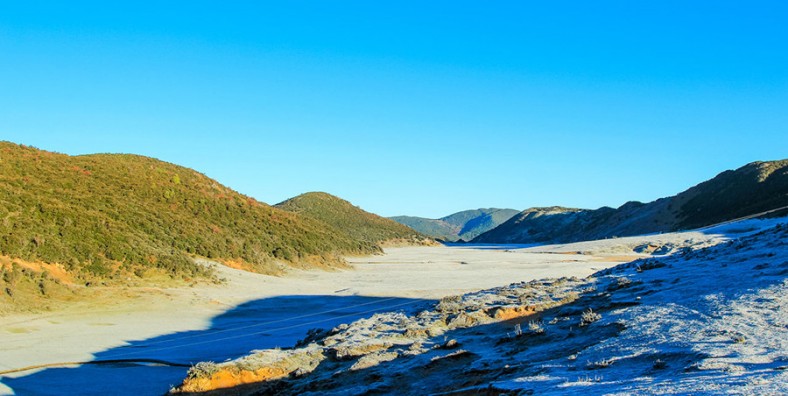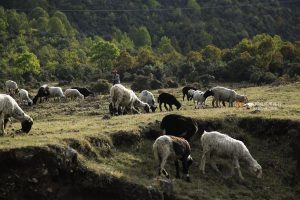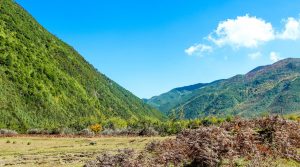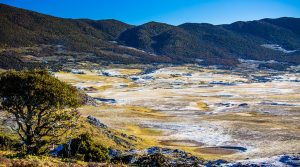Huadianba Meadow of Cangshan Mountain, Dali

Chinese Name:苍山花甸坝
Chinese Pinyin: Cang Shan Hua Dian Ba
English Name: Huadianba Meadow of Cangshan Mountain, Dali
Type: natural landscape
Altitude: 2900 meters
Opening Hours: all day
Recommended Visiting Hours: 4.5 hours
Ticket: RMB 30
Location: among the Yunnong and Canglang Peaks
Huadianba Meadow of Cangshan Mountain
Huadianba Meadow(苍山花甸坝) is a beautiful basin on the top of Cangshan Mountain, enjoying the rich natural resources and charming landscape.It consists of big and small Huadianba Meadow. Located among the Yunnong and Canglang peaks. The peak of the west is snowy all the year. 40 creeks collect into Wanhua River, as the main water resource of the basin. The entire Huadianba is flat and fertile. The exotic flowers and grasses compete for beauty. Every spring and summer, there are horses and cherry blossoms in the mountains and plains.It becomes the world of flowers.
Where is Hudianba Meadow?
Huadianba Meadow is located among the Yunnong and Canglang peaks of Cangshan Mountain, Dali City. Huadianba is an alpine basin, 2,900-3,200 meters high above the sea level, with the Dahuadian stretching 10 km from south to north, and 2 km from east to west. It’s inlaid between Yunnong and Cangshan Peaks, which are the northernmost part of the Cangshan Mt’s 19 peaks.
Distance from main attractions
24 km from the Cangshan Mountain
9 km from the Butterfly Spring
21 km from the Three Pagodas
7.3 km from the Gufo Cave
How to get to Huadianba Meadow?
Huadianba Basin is composed of two parts, Dahuadian and Xiaohuadian. Two routes to get there:
(1)-Starting from Zhoucheng Village, you can head westward to the foot of Canglang Peak, and then trek along the rugged footpath on Qigushan Mt to Xiaohuadian;
(2)-Heading westward from Xizhou Town, you need to ascend to Hongkui Mt of Wutaifeng Peak, and then trek northward to the centre of Huadianba.
Both routes will take approximately 6-7 hours. And for the sake of safety, we suggest trekkers resort to professional well-informed travel services and guides.
What to See

Escape from the crowd in the ancient city of Dali, indulge yourself in the world of expansive alpine meadows, a sea of rhododendrons and wild flowers in Huadianba Basin on the Cangshan Mt. Walking on the rustic footpaths is the biggest treat the nature gives, and the bumpy road offers a wild experience.
The underpopulated northwestern part of Yunnan is longed for by lots of hikers and trekkers each summer. There are a wide range of trekking routes in the prefectures of Dali, Lijiang, Diqing (Shangri-La) and Nujiang, from the world’s deepest gorge-the Tiger Leaping Gorge, to the Haba Snow Mt, to the hidden Tibetan village of Yubeng, and to the Nujiang Great Canyon.
The four-day trekking to Huandianba, on the Cangshan Mt of Dali, is an authentic eco tour and your access to the nature in summertime. Challenging alike, Huadianba is seemingly not so risky as the Tiger Leaping Gorge on the Yangtze River and Yubeng Tibetan Village at the foot of Meili Snow Mountain between Yunnan province and Tibet.
To the west of Huadianba are lofty snow-capped mountains, whose thawed water flows into around 40 streamlets to Huadianba’s main water source, the Wanhuaxi rivulet.

Far from the concrete world, Huadianba is a fertile land and home to a big variety of wild flowers, among which varied rhododendrons are the best flora views you take in in summertime. Most of mountains of Yunnan are home to different azaleas and other kinds of flowers. Among the Yunnan’s eight reputed flowers, which are azalea, gentian, lily, magnolia, meconopsis, orchid, camellia, and primrose, you can find azaleas and gentians are widely growing in the wild, such as the Mt Cangshan of Dali. A such wild tour features much more natural, though you can spend a full day wandering around flower markets in Kunming, like the Dounan Flower Market which starts early in the morning for florists.
Way of Visiting
To fulfill the outdoor programme, you can either rent a horse from locals, or trek all the way six or seven hours a day.
Trekking along the small basin, you can drop by villages here such as the Huangxiongwo, Langxiang, Shanshu, and Runiudun. Semantically, names of these four villages are related to animals and plants, e.g. Huangxiong-Yellow Bear, Lang-Wolf, Shan-Fir, and Runiu-Cow. At the highest point of Huadianba, you also can birds-eye view the Er’hai Lake and admire the fog-encircled Luopingshan Mt.
Camping and picnicking are two things you may find interesting to do, but you have to be well-quipped with waterproof outdoor travel kit such as tents and sleeping bags. But what we recommend is to lodge in locals-run inns and guesthouses where you may happily “squeeze” in a room with your partners.
Resources
In 1958, a state-owned farm was initiated here for locals to grow medicinal herbals, and develop animal husbandry. Elecampane, radix codonopsitis, Angelica sinensis, aconite, red deer, and yaks are what they grow and raise.

It’s a pastoral scene in Huadianba that herds graze at wild grasslands. Goats and cattle (mainly cows and yaks) are the main livestock peasants keep in northwestern Yunnan, and cheese seems too alien to most parts of China, but in this remote southwestern frontier, it is at times prepared to treat guests. Those livestock let you think of the “milk fan”, which is locally called “Ru Shan” in Chinese, and is a Bai ethnic snack Dali prides in. People in Dali make use of every inch of steppes, even in mountainous areas, to raise goats and cows for producing milk which is traditionally made into “milk fan” or cheese.
The poorly paved roads, not asphalted and overgrown with green weeds, are seldom frequented by normal tourists partly because Huadianba is too secluded from the outside world; but for hikers, there is more nature feel to retrieve and enjoy, as they can’t do so in big cities. On the way, you can find endless fun by observing every wild flower you encounter, every raspberry that makes your mouth watery, and livestock feeding on wild grasses.
Walking on the rustic footpaths is the biggest treat the nature gives, and the bumpy road offers a wild experience-if you rent a local horse. Like the Lashi Lake of Lijiang, Yila Grassland of Napa Lake, and the Tiger Leaping Gorge of Shangri-La, local farmers here have earned income by joining in the tourism industry. Anyway, horse riding sounds much more environmentally friendly than riding on a pollution-creating device in big cities.
Useful Travel tips
Best Time to Visit: The most beautiful seasons of Huadianba Meadow are months of May to June. Travelers can enjoy the booming flowers on this meadow.
















